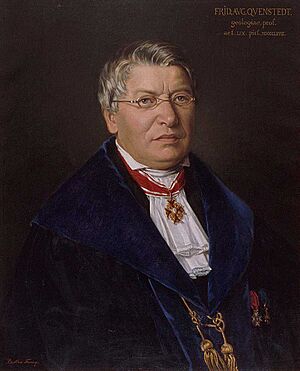Friedrich August von Quenstedt facts for kids
Friedrich August von Quenstedt (born July 10, 1809 – died December 21, 1889) was an important German geologist and palaeontologist. Geologists study Earth's rocks and history. Palaeontologists study ancient life, like fossils. Quenstedt helped us learn a lot about our planet's past.
Contents
About His Life
Friedrich August von Quenstedt was born in a town called Eisleben in Germany. He went to university in Berlin. After his studies, he worked at a museum. He was an assistant there for a while. Later, he became a professor at the Eberhard Karls Universität Tübingen. He taught about mineralogy (the study of minerals) and geognosy (the study of Earth's structure). This happened in 1841.
What He Studied
Minerals and Rocks
Quenstedt's early work was mainly about crystallography and mineralogy. Crystallography is the study of how crystals are formed. He wrote textbooks on these subjects. These books were used by many students.
Ancient Life and Fossils
He also became famous for his research on palaeontology. He was especially interested in fossils from the Jurassic period. This was a time long ago when dinosaurs lived.
In 1845, he created a special way to name Jurassic ammonites. Ammonites were ancient sea creatures with spiral shells. His naming system was a bit tricky for later scientists. He studied many ammonite fossils. He noticed some had coiled shells and others had uncoiled shells. He thought the uncoiled ones were unusual forms. He also wrote several articles about pterosaurs. Pterosaurs were flying reptiles that lived with dinosaurs.
Things Named After Him
Many things were named in his honor. These include five types of ancient animals:
- Quenstedtia (a type of clam)
- Quenstedtiphyllia (a type of sea creature)
- Quenstedtoceras (a type of ammonite)
- Quenstedticrinus (a type of sea lily)
Also, a specific type of ancient turtle, Proganochelys quenstedti, was named after him.
A mineral called quenstedtite was also named to honor him. This happened in 1888.
Supporting Other Scientists
Quenstedt also supported other scientists. For example, Maria von Linden was a German scientist. She wrote her first paper about minerals in the River Hürbe. This paper was read at a geology meeting in 1890. Quenstedt noticed her work and encouraged her. Maria von Linden later became the first woman in Germany to be called a professor.
His Main Books
Here are some of the most important books he wrote:
- Method der Krystallographie (1840)
- Das Flözgebirge Wurttembergs (1843)
- Petrefactenkunde Deutschlands (7 volumes and atlases, 1846–84)
- Die Cephalopoden (1846–49)
- Handbuch der Petrefactenkunde (2 volumes, 1852, with new editions in 1867 and 1882-85)
- Der Jura (2 volumes, 1858)
- Handbuch der Mineralogie (1855, with a new edition in 1877)
- Die Ammoniten des Schwäbischen Jura (1883–84)



